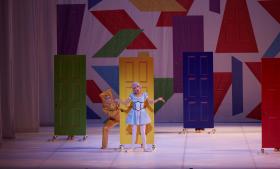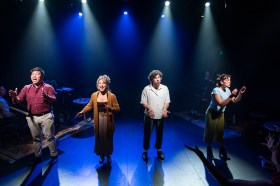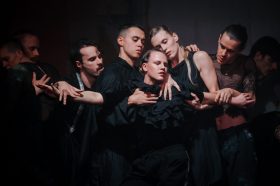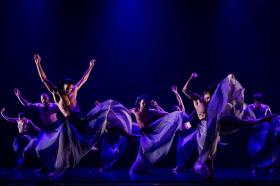Artists interested in and promoting the female nude may be the least surprising concept you’ll come across this year. Indeed, would there even be any history of art without it? Austrian choreographer Florentina Holzinger, however, has another, more radical agenda when she presents her troupe of female dancers stripped bare and utterly exposed. ‘You want to see women with their clothes off?’ she seems to be asking. ‘You think they’re beautiful?
‘Well, they are, but look at how ugly they can be too. And what different shapes they come in. Most of all look at how strong they are. Look at all the extraordinary things those bodies can do.’
If you’ve read the publicity or are a ballet aficionado, you will be aware that TANZ, the latest production from Austrian choreographer critiques the discipline, and like Darren Aronofsky’s Oscar-winning Black Swan, is a bold and searching piece that investigates the form to reveal the torturous realities behind its demands.
TANZ does this around the framework of a ballet class in which the famed German dancer Beatrice “Trixie” Cordua puts a group class through its paces, instructing, encouraging and praising as they go. From there, the action spreads (bursts?) into a world of vomit, violence and vanity ripped apart. And the supposedly genteel world of classical dance is torn asunder to consider its painful underpinnings. So far, so satirical.
But TANZ has been scheduled in a festival, and its publicity features images of bloodied bodies and suspended motorbikes, and seems to celebrate the nudity, gore and live body modification and suspension.
So, it’s the sort of work likely to attract the curious, the thrill seeker and the just plain ghoulish. Those people may not always intersect naturally with subscribers to The Australian Ballet, so what does TANZ mean to or for them?
How does a show like TANZ engage the casual observer?
For this viewer, the most salient point was the knowledge that Cordua was the first to dance La Sacre du Printemps in the nude, way back in the 70s. Indeed, the now 80-year-old, who has had a six-decade career and who nominates Hannah Arendt and Andy Warhol as two of her role models, has often danced in her birthday suit and thinks nothing of it. This explains how completely at ease she seemed when TANZ began and she was, to begin with, the only nude performer on stage.
And this is mightily reassuring, because it paints her as an iconoclast and ground-breaker of renown and mitigates the discomfort felt at the thought that an elderly woman has been merely used for shock value and to make a point about transgression by subjecting her to such indignities as being daubed with fake blood and forced to give birth to a rat.
But was it transgressive anyway? In Melbourne at least, we’re used to on stage nudity. Maude Davey even wrote a show referring to a career spent completely déshabillé (although of course she has done so very much more than that). And having a rodent removed from your nether regions? We can look to Davey again for what she used to do with strawberries decades ago. How about on-stage body modification? That too does seem all very 90s and nothing that those ‘Wicked Women’ didn’t do back in the day.
If you’re spending a performance thinking about the mechanics rather than the effect, is it a successful performance? Perhaps there were others in the audience transfixed by the question of repetition as related to suspension. Brushing aside the memories of Richard Harris in A Man Called Horse, when a performer has hooks inserted into their back (transmitted to the audience via a close-up from the on-stage video camera) and is then suspended mid-air and twirled around in ever-increasing ellipses, it’s hard not to be pulled out of the performance and into considerations of logistics. Do the holes heal between performances? Are they long-standing holes cleverly plugged up and made to look as if they are pierced anew each time? Or does the production find a fresh and willing participant for each show?
Read: Film installation review: Euphoria, RISING
A one-off for such procedures is one thing, but nightly shows – how does it work? Of course, the answer isn’t really that important or interesting. It’s more the fact that wondering about such things implies a disengagement with the actual material and the message the performance is attempting to impart.
And when a long show eschews an interval, instead favouring a broken fourth wall, for Holzinger to deliver a rambling and seemingly ad libbed monologue about both the nature of the production and the audience’s reaction to it, then it’s hard not to suspect that there is not the confidence in the work that it will speak for itself.
To be clear TANZ was never dull and did have moments of wonder and even the sublime. Cordua‘s lengthy instructions to the dancers at the barre as they slowly disrobed – ‘yes, yes, take off your things, it’s very hot’ – was not only a fascinating masterclass in both the mechanics of ballet and the more problematic elements of the discipline.
TANZ was performed at the Playhouse Theatre, Arts Centre Melbourne from 8-10 June 2023 as part of RISING Festival.





